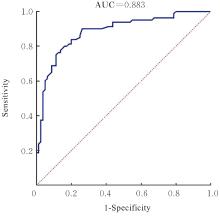| [1] |
Honghong LI,Na YU,Minghao SHI,Ying SUN,Yao LI,Zhongjun SHEN,Xiaoyi LIU,Liyan ZHAO.
Predictive value of new thrombotic risk assessment model for venous thromboembolism in patients with malignant tumors
[J]. Journal of Jilin University(Medicine Edition), 2024, 50(5): 1390-1399.
|
| [2] |
Jiayuan YU,Di ZHAO,Xin JIANG,Jing XU,Lili JIANG,Hongyu JIANG.
Association analysis on peripheral blood lymphocyte subsets and occurrence of carotid atherosclerosis
[J]. Journal of Jilin University(Medicine Edition), 2024, 50(5): 1400-1405.
|
| [3] |
Peng QI,Xianying MENG,Meihua PIAO,Qiang ZHANG.
Network Meta-analysis on risk factors of recurrence of papillary thyroid microcarcinoma
[J]. Journal of Jilin University(Medicine Edition), 2023, 49(6): 1504-1512.
|
| [4] |
Xiunan FENG,Lu CHEN,Yu LONG,Zhenyu JIANG,Ling ZHAO.
Analysis on clinical characteristics and risk factors of patients with Sjogren’s syndrome complicated with interstitial lung disease
[J]. Journal of Jilin University(Medicine Edition), 2023, 49(6): 1513-1518.
|
| [5] |
Xue DONG, Jinfeng ZANG, Caifeng XU, Hebing LIU, Zhaohua CHENG.
Construction and validation of risk prediction model of enteral nutrition feeding intolerance of patients with severe acute pancreatitis
[J]. Journal of Jilin University(Medicine Edition), 2023, 49(6): 1586-1592.
|
| [6] |
Tong SHEN,Yang WANG,Wei JIN,Zhihui LIN,Li YAN.
Risk factors analysis and risk model construction of cognitive frailty in elderly patients with chronic diseases
[J]. Journal of Jilin University(Medicine Edition), 2023, 49(5): 1304-1309.
|
| [7] |
Mingfei JU,Chao LIU,Zhigang MA,Juan ZHAO,Tu WANG,Zhihao WANG.
Predictive value of residual cholesterol in occurrence of patients with acute coronary syndrome
[J]. Journal of Jilin University(Medicine Edition), 2023, 49(3): 765-769.
|
| [8] |
Lianyuan WANG,Yi YANG,Huiwen CONG,Haohua WANG,Qihan BAO,Chengsheng LI,Liwen ZHOU,Zichen DING,Yanli LI,Fuyan SHI,Suzhen WANG.
Bayesian quantile regression joint model analysis on risk factors of Alzheimer’s disease in people with different MMSE scores
[J]. Journal of Jilin University(Medicine Edition), 2023, 49(2): 395-401.
|
| [9] |
Shan GAO,Yutong WANG,Minqiu LU,Lei SHI,Bin CHU,Yuehua DING,Mengzhen WANG,Li BAO.
Analysis on causes for early death and its risk factors of patients with multiple myeloma in era of novel drugs
[J]. Journal of Jilin University(Medicine Edition), 2022, 48(3): 783-789.
|
| [10] |
ZHANG Haolong, YU Zhentao, GAO Zihan, WU Yuanyu, FANG Xuedong.
Related risk factors and clinical treatment of patients with PGS after gastric cancer operation
[J]. Journal of Jilin University(Medicine Edition), 2019, 45(03): 673-677.
|
| [11] |
JIANG Rui, LIU Fang, PAN Yueji, LU Boyang, HOU Lulu, WANG Chunmei, JIA Hui, SHI Xiaoru.
Screening and analysis of dry eye in eye discomfort patients in Jilin Province
[J]. Journal of Jilin University Medicine Edition, 2017, 43(04): 832-838.
|
| [12] |
ZHOU Hong, LIU Jincai, LUO Guanghua, XIE Peihan, YANG Juan, DONG Yulan, QING Weipeng, ZHANG Jingjing.
Application of Coronary Artery Disease-Reporting and Data System in risk factor analysis of patients with coronary artery disease
[J]. Journal of Jilin University Medicine Edition, 2017, 43(03): 617-622.
|
| [13] |
SI Henan, ZHONG Shuxia, ZHOU Junfeng, YAO Lei, LIU Yuanyuan, SONG Yang, LI Shanshan.
Analysis on clinical characteristics and risk factors of 271 children with vitiligo
[J]. Journal of Jilin University Medicine Edition, 2017, 43(01): 147-150.
|
| [14] |
GUO Li, ZHANG Xiaoxia, YU Meiling, ZHAO Ting, ZHANG Liqun.
Preventive effect of hydroxyethyl starch solution on ovarian hyperstimulation syndrome
[J]. Journal of Jilin University Medicine Edition, 2016, 42(06): 1147-1150.
|
| [15] |
GU Sanwei, MA Hongshuang, ZHAO Ling, JIANG Zhenyu.
Analysis on clinical characteristics of PM/DM combined with thyroid disease
[J]. Journal of Jilin University Medicine Edition, 2016, 42(05): 999-1004.
|
 )
)





